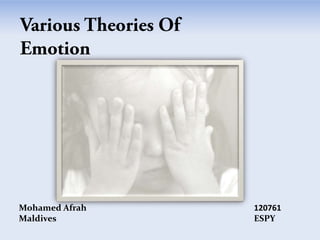
various theories of emotion
- 1. Mohamed Afrah 120761 Maldives ESPY
- 2. Emotion Evolutionary Theories, Social & Cultural Theories, Theories of Emotion Process Conclusion
- 3. Emotion is a type of affect, other types being mood, temperament and sensation Emotions can be understood as either states or as processes A type of mental state that interacts with other mental states and causes certain behaviors.
- 4. Early: the interval between the perception of the stimulus and the triggering of the bodily response Later: a bodily response, for example, changes in heart rate, skin conductance, and facial expression.
- 5. Theories of emotion can be categorized in terms of the context within which the explanation is developed. The standard contexts are evolutionary, social and internal.
- 6. The evolutionary approach focuses on the historical setting in which emotions developed This has not prevented the development of theories that explain emotions as adaptations Since all humans have emotions and most non- human animals display emotion-like responses It is likely that emotions (or emotion-like behaviors) were present in a common ancestor
- 7. emotions appear to serve an important function, which has led many to think that the certain emotions have been selected to deal with particular problems and challenges that organisms regularly encounter “Emotions have the hallmarks of adaptations: They are efficient, coordinated responses that help organisms to reproduce, to protect offspring, to maintain cooperative alliances, and to avoid physical threats” -Dacher Keltner-
- 8. Two different ways in which the evolutionary position has been developed o the claim that emotions are the result of natural selection that occurred in early hominids o that emotions are adaptations, but suggests that the selection occurred much earlier
- 9. Natural Selection in Early Hominids in response to problems that arose because of the social environment in which these organisms lived. the time period during which this selection is believed to have occurred is typically not specified with any precision
- 10. Adaptations Shared by all Animals the adaptations are shared by a wider collection of species today there are eight basic emotions, each one is an adaptation, and all eight are found in all organisms . Robert Plutchik
- 11. Adaptations Shared by all Animals The eight adaptations:
- 12. Adaptations Shared by all Animals
- 13. emotions are the products of societies and cultures, and are acquired or learned by individuals through experience the central claim made in these theories is that the social influence is so significant that emotions are best understood from this perspective.
- 14. Motivation for Social Approach A number of anthropological studies have found discrepancies among the emotion words used in different languages there are emotion words in other languages that do not correspond directly or even closely to emotion words in English
- 15. Motivation for Social Approach Emotions typically occur in social settings and during interpersonal transactions Emotions and their expression are regulated by social norms, values, and expectations Emotions and their expression are regulated by social norms, values, and expectations
- 16. Emotions are transitory Social role; “an emotion is a transitory social role (a socially constituted syndrome) that includes an individual’s appraisal of the situation and that is interpreted as a transitory than roles are the -Avrill- passion rathersocialas an action” roles that individuals adopt when they choose to play a particular part in a situation as it unfolds The transitory social roles are rule governed ways of performing a social role
- 17. the emotion process begins with the perception of a stimulus The early part of the emotion process is the activity between the perception and the triggering of the bodily response the later part of the emotion process is the bodily response: changes in heart rate, blood pressure, facial expression, skin conductivity, and so forth
- 18. lead to competing cognitive and non-cognitive theories somatic feedback theories
- 19. Cognitive Theories the manipulation of information and so should be understood as a cognitive process Two observations demonstrate some of the motivation for the cognitive position First different individuals will respond to the same event with different emotions
- 20. Cognitive Theories second a wide range of seemingly unrelated events that cause the same emotion Cognitive theories account for these two observations by proposing that the way in which the individual evaluates the stimulus determines the emotion that is elicited
- 21. Non-cognitive Theories defend the claim that judgments or appraisals are not part of the emotion process in many ways a development of the folk psychological view of emotion
- 22. Somatic Feedback Theories all maintain that it is the cognitive activity that determines the specific emotion that is produced The somatic feedback theorists differ from the cognitive and non-cognitive positions by claiming that the bodily responses are unique for each emotion and that it is in virtue of the unique patterns of somatic activity that the emotions are differentiated.
- 23. This Presentation has outlined the basic approaches to explaining the emotions, it has reviewed a number of important theories, and it has discussed many of the features that emotions are believed to have
